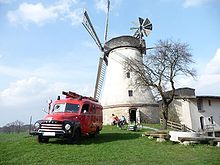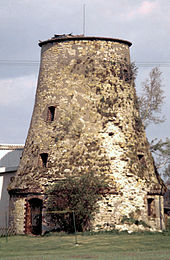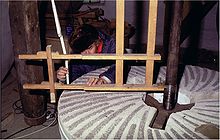Lechtingen windmill
The Lechtingen windmill is a listed Dutch windmill in Wallenhorst in Lower Saxony. It is the landmark of the Wallenhorst district of Lechtingen .
Mill type
The Lechtingen windmill is a Dutch windmill, but only with half a gallery. This is because the windmill was built into a former quarry. The other half is designed as a Wallholländermühle . The mill is currently equipped with sail gate wings and a wind rose .
history
The windmill was built between November 1886 and December 1887 by Johann Rudolf Pagenstecher . Until 1879 he was a miner in the nearby Piesberg coal mine . With the construction of the mill, he wanted to create an opportunity for the workers in Piesberg to have their grain, which had been harvested on the sideline, ground, but on the other hand he also intended to use the mill drive to irrigate his own arable land near the mill. It can no longer be proven whether this irrigation was actually still in operation.
Pagenstecher had never intended to run the mill himself. He leased the mill to the miller Heinrich Wolting from Dalvers in the Bersenbrück district . During this first lease period, a steam boiler was purchased , which suggests that a motor mill must have already existed next to the windmill. After 17 years, Wolting canceled the lease and took over the Feldteichsmühle belonging to the Schoeller company in Gretesch.
The mill builder's granddaughter, Marie Pagenstecher, sold the mill in 1905 to the miller Wilhelm Uhlendorf . At that time the windmill is described as a Dutch windmill with a cap that rotates automatically in the wind. The wings had sheet metal blinds that were operated from inside the mill. The motor mill was equipped with a suction gas motor from the Herford machine works. Due to an accident in the mill, Wilhelm Uhlendorf died in 1910 at the age of 40.
The brother of the casualty, August Uhlendorf , born in Osnabrück in 1868 , leased the mill from 1910. The mill business was doing well and during the First World War the women and children helped to get the job done. On December 15, 1919, the motor mill burned out completely. There is no precise information about the condition of the windmill at this time. Until 1918 the windmill could still work on its own. After that, a drive shaft from the motor mill was probably placed in the windmill. Presumably due to poor maintenance, the mill lost its cap in a storm in 1922 or 1928. The windmill was then covered with a flat roof. Ms. Ella Uhlendorf, August Uhlendorf's wife, rebuilt the motor mill after the fire.
On April 1, 1921, Adolf Telscher took over the mill as the new tenant. Adolf Telscher had to cancel the lease at the end of 1924 due to the difficult economic conditions caused by inflation and the downtime of the mill due to repairs during the main harvest season.
The subsequent tenant, Anton Langhorst , who leased the mill in July 1925, probably did not have a good time either. He left Lechtingen again in 1928.
From March 1928 to October 1930 the mill was leased to Johannes Brömmelhaus .
Georg Kreuzkamp bought the mill on February 14, 1931 . In the first few years he rebuilt the house and fortified the mill yard. The motor mill was expanded between 1938 and 1939. The building was raised by one floor and equipped with roller mills , elevators , plansifters and cleaning machines. This facility is still there today. The drive now took place with an electric motor. From 1948 to 1949 Georg Kreuzkamp was appointed mayor of Lechtingen by the Allies . After Georg Kreuzkamp's death in 1959, his wife, Helene Kreuzkamp, continued to run the business. From 1964 to 1970 the mill was leased one last time. However, the tenant only operated a land trade.
Georg Kreuzkamp's daughter, Mrs. Annelene Dallmöller, has owned the mill since 1962. In 1982 she leased the run-down windmill to the newly founded Windmühle Lechtingen eV association
At the beginning of 2008, the municipality of Wallenhorst acquired the mill building and leased it to the mill association.
Restoration from 1982 to 1987
From 1982 to 1987 the windmill was completely restored. The masonry was almost completely rebuilt, the beams in the interior had to be partially renewed, new floors were put in, a new cap was made and finally new wings and grinding technology were installed. In 1987, just in time for the 100th anniversary, the windmill could be put back into operation. The mill is equipped with a shot gallery and a hexagonal sifter. It is regularly shown in action.
Technical specifications
- Total height without sash - 19 m
- Wing cross in diameter - 21 m
- Area exposed to wind - 68 m 2
- Millstones diameter - 140 cm
- Weight Bodenstein - 850 kg
- Weight runner stone - 1,250 kg
Events
Mill day
The mill festival, which has been taking place at the windmill since 1984, developed into the 1st Lower Saxony Milling Day on June 4, 1990 (Whit Monday) with 15 participating mills, mainly from the Osnabrück area. On the 4th Lower Saxony Milling Day on May 31, 1993, 79 mills from Lower Saxony and Bremen took part. The following year, on May 23, 1994, the 1st German Milling Day was celebrated under the umbrella of the German Society for Milling Knowledge and Mill Maintenance (DGM) . About 1000 mills all over Germany took part in the German Milling Day, which took place in 2009.
Open Monument Day
The organic and handicrafts market originally held in September became the mill market over time. On the 2nd Sunday in September, on the day of the open monument , the mill association and the Wallenhorst tractor friends organize another festival. The Wallenhorst tractor friends show old agricultural machines in operation.
Current
The mill is open for guided tours at any time. You can shop in the mill shop every Saturday from 10 a.m. to 12 p.m. From April to October the mill is open on the first Sundays of the month. Various activities take place on these Sundays.
The mill association intends to restore the completely preserved motor mill as well. The renovation measures are expected to cost 300,000 euros and be completed by the end of 2018. The motor mill can then be driven either by a Herford diesel engine or, alternatively, by an electric motor. In addition to two grist passages, the mill has a complete cleaning system. The actual grinding device consists of two roller mills, plansifter, flour mixer and suction. There is also an oat crusher and a seed cleaning facility .
literature
- Kurt Jünemann (Ed.): Windmühle Lechtingen. 1887–1987 (= publications of the working group for the history of the municipality of Wallenhorst. Issue 5). Self-published by the Wallenhorst - Osnabrück District, Osnabrück 1987.
- Heinz Rölker: Windmill Lechtingen (= German mill guide. Issue 3). Association for the Preservation of Windmills and Watermills in Lower Saxony and Bremen, Osnabrück 1991, ISBN 3-929353-02-4 .
Web links
Individual evidence
- ↑ Christina Halbach: Sparkassenstiftung supports the renovation of the motor mill in Lechtingen. In: New Osnabrück Newspaper. January 12, 2018, accessed January 13, 2018 .
Coordinates: 52 ° 20 ′ 30 ″ N , 8 ° 2 ′ 3 ″ E


